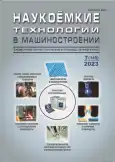ANALYTIC REPRESENTATION OF THE FRICTION FORCE-TEMPERATURE RELATIONS UNDER THE CONDITIONS OF FRICTIONAL INTERACTION OF SPATIALLY-ORDERED RUBBERS HAVING STEEL SURFACE
- Authors: Breki A.D.1
-
Affiliations:
- St. Petersburg Polytechnic University Peter the Great, Institute of Problems of Machine Science of the Russian Academy of Sciences
- Issue: No 7 (145) (2023)
- Pages: 33-38
- Section: Surface layer quality, contact interaction, friction and wear of machine parts
- URL: https://bakhtiniada.ru/2223-4608/article/view/350092
- DOI: https://doi.org/10.30987/2223-4608-2023-7-33-38
- ID: 350092
Cite item
Full Text
Abstract
The analysis of the known friction-temperature laws is carried out in the article. A mathematical model of external friction of F.F. Ling and E. Seibel coefficient dependence on temperature, activation energies of formation and destruction of friction bonds and other factors, developed using the equations of absolute rates of chemical reactions, is analyzed. An approxima-tion of this model is implemented in temperature independence case for Bowden and Tabor shear strength. A mathematical model, describing sliding friction force-temperature relation under frictional interaction of spatially ordered rubbers hav-ing steel surface, is proposed. A distinctive feature of the proposed mathematical model is that it can simultaneously describe areas of constancy, friction force linear and nonlinear scaling under temperature changes. The testing and verification of the developed mathematical model is fulfilled through digitizing and processing experimental data, obtained by the fric-tional interaction of bars, made of spatially ordered natural rubber and spatially ordered rubber SCS-50 with a prism made of steel st.3. Analyzing the approximating dependencies, it is found, that for spatially ordered natural rubber, the maximum value of the friction force is 2,0 kgf under the temperature of approximately 37,6 ℃, and the average value of the friction coefficient is 0,987, for spatially ordered natural rubber, the maximum value of the friction force is 1.84 kgf under the tem-perature of approximately 31,4 ℃, while the average value of the coefficient of friction is 0,853. New tribotechnical charac-teristics have been introduced making possible to give a more detailed characterization of the frictional interaction in the rubber-steel system for the cases of temperature changes.
About the authors
Alexander Dzhalyul'evich Breki
St. Petersburg Polytechnic University Peter the Great, Institute of Problems of Machine Science of the Russian Academy of Sciences
Author for correspondence.
Email: andrnikolajev@gmail.com
ORCID iD: 0000-0002-4452-3896
doctor of technical sciences
References
Розов Ю.Г. Влияние характера распределения темпе-ратур в объеме трубной заготовки на неоднородность поля сопротивления деформированию в операциях ли-стовой штамповки // Известия ТулГУ. Технические науки. 2013. Вып. 7. Ч. 2. С. 36-43. EDN: RNKKNL Михин Н.М. Внешнее трение твердых тел / Н.М. Михин; АН СССР, Науч. совет по трению и смаз-кам, Ин-т проблем механики. М.: Наука, 1977. 221 с. Крагельский И.В. Основы расчетов на трение и износ / И.В. Крагельский, М.Н. Добычин, В.С. Комба-лов. М.: Машиностроение, 1977. 526 с. Черепанов В. А. Химическая кинетика: [учеб. пособие] / В. А. Черепанов, Т. В. Аксенова ; М-во обра-зования и науки Рос. Федерации, Урал. федер. ун-т. Екатеринбург: Изд-во Урал. ун-та, 2016. 132 с. EDN: WKKTXF Буданов В.В. Химическая кинетика: учебное пособие / В.В. Буданов, О.В. Лефедова; Иван. гос. хим.-технол. ун-т. - Иваново, 2011. 177 с. Breki A.D. Mathematical regularities of the slid-ing friction process of a porous material based on iron im-pregnated with lubricating oil with dispersed particles of fluorinated graphene / A. D. Breki, S. G. Chulkin, N. M. Dobrovolsky [et al.] // Chebyshevskii Sbornik . 2021. Vol. 22, No. 1 (77). P. 378-389. doi: 10.22405/2226-8383-2021-22-1-378-389. EDN: BDPYUB Бреки А.Д. Математические закономерности изменения характеристик процесса трения пористого композиционного материала на основе меди, содержа-щего масло с частицами графена / А. Д. Бреки, С. Г. Чулкин, А. Г. Колмаков [и др.] // Чебышевский сборник. 2021. Т. 22. № 1 (77). С. 390-402. doi: 10.22405/2226-8383-2021-22-1-390-402. EDN: QHYADC Breki A.D. Semiempirical Mathematical Models of the Pivoting Friction of ShKh15 Steel over R6M5 Steel according to the Ball-Plane Scheme with Consideration of Wear / A. D. Breki, A. E. Gvozdev, A. G. Kolmakov // Inor-ganic Materials: Applied Research. 2019. Vol. 10, No. 4. P. 1008-1013. doi: 10.1134/S2075113319040075. EDN: KSETBH Бартенев Г.М., Елькин А.И. О механизме трения высокоэластичных материалов при высоких и низких температурах / Теория трения и износа: [Сбор-ник статей] // Акад. наук СССР. Науч. совет по трению и смазкам. М.: Наука, 1965. С. 95-99. Бреки А. Д. Чулкин С.Г., Шалыгин М.Г. Аналитическое представление зависимостей коэффи-циента трения от температуры при фрикционном взаи-модействии стального шара с термопластами // Науко-емкие технологии в машиностроении. 2022. № 6 (132). С. 27-32. doi: 10.30987/2223-4608-2022-6-27-32. EDN: ITVOKA
Supplementary files









